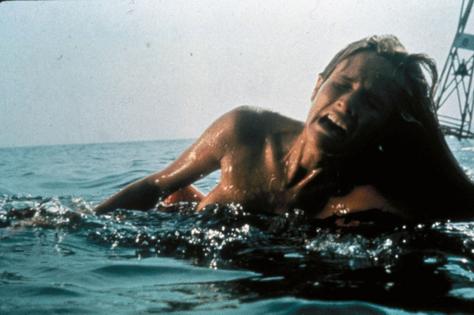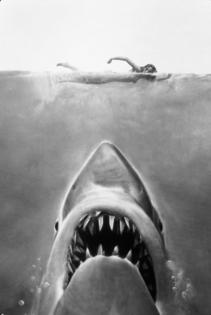'Jaws' at 50: One critic's complicated love of shark movies
Published in Entertainment News
SEATTLE — When looking back at the impact of Steven Spielberg’s “Jaws,” which premiered in theaters on June 20, 1975, it’s easy to focus on the financial.
Sure, “Jaws” made buckets of money, is widely considered the very first summer blockbuster movie, changed the course of filmmaking forever and introduced the most stressful two-note melody in musical history thanks to John Williams’ Oscar-winning score. Very impressive.
Personally, I celebrate “Jaws’” impact through its successors. In the 50 years since “Jaws” opened, there have been, conservatively, one billion shark horror movies made, (almost) all of which I deeply and unironically love. Give me a lone dorsal fin slashing through dark waters or a shark-shaped shadow in a crystal blue lagoon and I’m hooked (no pun intended).
The shark movie is an endlessly permutable genre, with a strong chance of tropical travel scenes, an even stronger chance of collaborative problem solving and a low chance of intentional cruelty toward humans. Sharks are gonna shark, you know? (Critically, this vilification of “shark-as-mindless-maneater” is inaccurate and has dangerous real-world implications, but more on that later.)
As “Jaws” turns 50, let’s look back on its industry-changing success, my over-the-top love for the many shark movies it spawned, and how the genre’s popularity has posed big problems for real-life sharks.
Birth of the blockbuster
Based on Peter Benchley’s 1974 book of the same name, “Jaws” was filmed in Martha’s Vineyard and set on the fictional East Coast beach town of Amity Island. The famously fraught film shoot relied heavily on practical effects, including a finicky mechanical great white shark nicknamed Bruce.
Even though the movie’s budget ballooned from $4 million to more than $8 million during filming, the investment was worth it. “Jaws” was the first film to earn $100 million at the box office, according to Guinness World Records and, according to the American Film Institute, “ushered in a lucrative new era for Hollywood in which franchises were supported with multimillion-dollar marketing campaigns, saturation booking at theaters nationwide and merchandising tie-ins, a model that still continues today.”
In an interview published in 2002 shortly after her death, longtime New Yorker film critic Pauline Kael lamented those changes “Jaws” wrought in the film industry.
“A few movies made inordinate amounts of money, and everything we hoped for from movies went kerplooie,” she said. “A good movie brought in terrible consequences. ‘Jaws’ is really a terrific movie. I laughed all the way through it. Yet it marked something. Then, with ‘Star Wars’ coming on top of it, that awful ‘Star Wars’ and its successors, movies have just never been the same.”
It’s love, not logic
After “Jaws” tackled the premise of “Oh no, a shark!” filmmakers had to get creative, and get creative they did.
Over the years, shark movie plots have gotten weirder, wilder and more wonderful. Sharks are genetically engineered geniuses (“Deep Blue Sea”); sharks are prehistorically huge (“The Meg”); and sharks are somehow breeding in ancient French sewers (“Under Paris”).
My willingness to hit play on just about any shark movie stems from sharks being excellent movie villains and oceans a perfect backdrop for thrillers, rife with logical and deadly serious obstacles. But it all begins with the movie’s setting.
Often, we’re dropped into the relaxing, pellucid waters of some tropical isle — the lighter the water, the better the blood shows up when it inevitably plumes from someone’s chomped limb. When Blake Lively gets yoinked off her surfboard in “The Shallows,” we barely see the shark that yoinked her. But as the clear water suspending her hair in a blond halo slowly transforms into a vivid transparent red, we know exactly what we’re up against.
That tension sparks visceral thrills, rather than the eye-covering, ear-plugging fear that a horror movie with a human villain can engender.
Sharks (or movie sharks, anyway) are beautiful, brutal and calculating (but not cruel) adversaries. So, shark movies usually aren’t about hate or revenge, they’re about problem-solving.
Because of their aquatic settings, shark movies come with natural challenges for human protagonists who are racing against time, tide, dehydration and oxygen. When Mandy Moore is trapped in a shark cage that has detached from its boat in “47 Meters Down,” she can’t race to the surface because she’d get the bends, which would kill her just as surely as the shark patrolling the waters between her and the surface.
I personally prefer the sequel “47 Meters Down: Uncaged” to the original. In it, a group of young women cave-diving in the submerged ruins of an ancient Mexican city stumble upon sharks that have evolved to be blind. The setting is gorgeous. The dad is some sort of underwater archaeologist played by John Corbett. It’s beautiful, earnest, and takes an absurd premise and stretches it as far as logically possible. Five hundred stars.
Both are very good shark movies filled with escalating tensions, actors willing to chew the scenery, a strict adherence to the logical world of the film, and many satisfying reversals in the battle between man and beast. But let’s be honest, “Uncaged” is more fun. For me, blending winking self-awareness and straightforward engagement with an over-the-top premise is the winning combo.
This seems like a good time to mention that I do not care for the “Sharknado” series because those movies beg to be campy cult hits which, for me, has the same cringe factor as giving yourself a nickname. Beyond that, however, my capacity for the ridiculous knows few bounds.
Silly movies, serious consequences
Like the dangers in any horror film, movie sharks can’t be taken at face value. Generally speaking, sharks have little interest in humans and the chances of a random attack, let alone a deadly one, are hugely overblown.
According to the International Shark Attack File reports, fewer than 15% of unprovoked great white shark attacks have been fatal since record keeping began in 1580.
As a species, sharks are a marvel. They’re apex predators that have survived for 400 million years, through every mass extinction event on planet Earth, and today, they help protect the balance in marine ecosystems, which contribute to the health of the oceans and the climate overall.
They’re being decimated by commercial and recreational fishing and the shark fin trade, which kills tens of millions of sharks every year. But garnering public support for protecting sharks is an uphill battle thanks to decades of bad film PR.
We’ll never quantify how much shark movies have contributed to the devastation of shark populations. According to Shark Stewards, a California-based conservation nonprofit, “Jaws” “led to vendetta killings, great white shark tournaments (and) a commercial fishery that along with bycatch in a gillnet fishery, almost completely wiped out the population of white sharks along the west coast of North America.” Both Spielberg and Benchley have expressed regret for how sharks were represented in the movie and book.
Some modern shark movies — including “Under Paris,” which features a plotline about eco-activists dedicated to shark conservation — grapple with the need to maintain their villain as a satisfying opponent while acknowledging the distress shark populations have faced, thanks in part to shark movies. In “Dangerous Animals,” which recently premiered at Cannes, director Sean Byrne reportedly said he “was excited to finally make a shark film that didn’t vilify the shark,” thereby doing its part to right the wrongs of “Jaws.” (Whether this is, in fact, a shark movie, or if it’s a serial killer movie with sharks in it is up for debate!)
As viewers, we can hold these truths at the same time: Shark movies are fun and they’re works of fiction, as much as any other horror movie. Don’t listen to them when they tell you, “You’ll never go back in the water.” ‘Tis the season of the shark movie, so dive back in with me, the water’s fine.
———
(Gemma Wilson is The Seattle Times arts and culture writer)
———
©2025 The Seattle Times. Visit seattletimes.com. Distributed by Tribune Content Agency, LLC.


















Comments